

AFR May 15. May 15. Jobless obsession offers PM’s best chance of survival Sydney Morning Herald, 5 18 2020. Future Outlook. The future of Australian jobs is strong, with the number of workers in most industries expected to grow over the next five years.
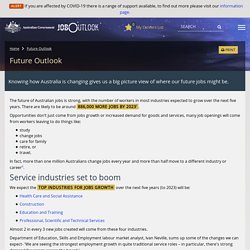
There are likely to be around 886,000 more jobs by 2023i. Opportunities don’t just come from jobs growth or increased demand for goods and services, many job openings will come from workers leaving to do things like: study change jobs care for family retire, or travel. In fact, more than one million Australians change jobs every year and more than half move to a different industry or careerii. Service industries set to boom We expect the top industries for jobs growth over the next five years (to 2023) will be: Almost 2 in every 3 new jobs created will come from these four industries. Australianjobs2019.
Financial Review, Thursday, April 9, 2020, pages from 6 to 6. Sydney Morning Herald Digital Edition. Sydney Morning Herald, Thursday, April 9, 2020, pages from 22 to 22. Sydney Morning Herald, Thursday, April 9, 2020, pages from 25 to 25. AFR fri Pt4. Financial Review, Thursday, April 9, 2020, pages from 6 to 6. CE July August 2019 Text. AFR fri Pt4. Financial Review, Thursday, April 9, 2020, pages from 6 to 6. Sydney Morning Herald, Thursday, April 9, 2020, pages from 25 to 25.
Sydney Morning Herald, Thursday, April 9, 2020, pages from 22 to 22. Sydney Morning Herald Digital Edition. Stimulus halted slump, data shows Sydney Morning Herald, 4 9 2020. Australian Economics Statistics – Warringal Publications. This graph shows that: Every quarter between 2013-14 and 2017-18 the annual rate of economic growth has fluctuated between 2% pa and 3% pa.
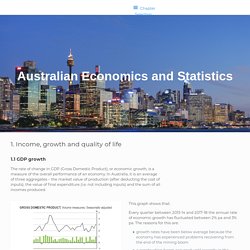
The reasons for this are: growth rates have been below average because the economy has experienced problems recovering from the end of the mining booma construction boom occurred until recently in the building of houses and home unitsgovernment infrastructure projects and mining exports are again contributing to growth. Australia has survived another economic shock, i.e. the slower rate of mining investment, and has maintained its long period of economic growth. We have now had 27 years without a recession. Australias Welfare Chapter 5 summary 18Sept2019. Centre for Future Work. Skills, Technology and the Future of Work.
Australia labour market – getting worse as unemployment and underemployment rise – Bill Mitchell. The Australian Bureau of Statistics released of its latest data today (February 20, 2020) – Labour Force, Australia, January 2020 – which continues to show that the Australian economy is in a weak state with a fairly moderate labour market performance being recorded for the start of 2020.
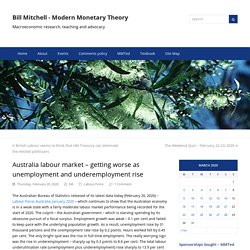
The culprit – the Australian government – which is starving spending by its obsessive pursuit of a fiscal surplus. Employment growth was weak – 0.1 per cent and failed to keep pace with the underlying population growth. As a result, unemployment rose by 31 thousand persons and the unemployment rate rose by 0.2 points. Hours worked fell by 0.45 per cent. The only bright spot was the rise in full-time employment. 6202.0 - Labour Force, Australia, Feb 2020. LABOUR FORCE COMMENTARY February 2020 Australia's trend estimate of employment increased by 21,100 people in February 2020, with: the number of unemployed people decreasing by 1,300 people; the unemployment rate remaining steady at 5.1%; the underemployment rate remaining steady at 8.6%; the underutilisation rate remaining steady at 13.7%; the participation rate remaining steady at 66.0%; and the employment to population ratio remaining steady at 62.6%.
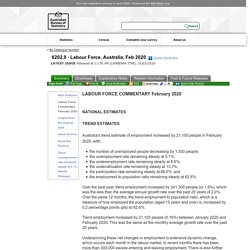
Over the past year, trend employment increased by 241,300 people (or 1.9%), which was the less than the average annual growth rate over the past 20 years of 2.0%. Over the same 12 months, the trend employment to population ratio, which is a measure of how employed the population (aged 15 years and over) is, increased by 0.2 percentage points (pts) to 62.6%. Trend employment increased by 21,100 people (0.16%) between January 2020 and February 2020. The labour force includes the total number of employed and unemployed people.
GRAPH 1. Australia Faces New Challenges as Labour Market Softens - Indeed Hiring Lab Australia. Key points: Australian employment growth has slowed and is no longer sufficient to bring the unemployment rate down.

Wage growth has softened to 2.2% and remains below its average over the past decade in every industry except healthcare.Australia still has a youth unemployment problem, with young men struggling to find work and young women wanting more hours. The Australian labour market is showing signs of fatigue, with employment growth softening and unemployment drifting up. The economy has struggled throughout 2019, growing at its slowest pace since the beginning of the global financial crisis and prompting concern over the outlook for jobs. Calls are getting louder for greater fiscal stimulus in the form of programmes that promote economic growth and boost employment. Australia Labor Force Participation Rate. Labor Force Participation Rate in Australia decreased to 66 percent in February from 66.10 percent in January of 2020.

Labor Force Participation Rate in Australia averaged 63.36 percent from 1978 until 2020, reaching an all time high of 66.20 percent in August of 2019 and a record low of 60.10 percent in April of 1983. This page provides the latest reported value for - Australia Labor Force Participation Rate - plus previous releases, historical high and low, short-term forecast and long-term prediction, economic calendar, survey consensus and news. Employment Outlook Australia EN. Labour market trends - Think Learn Act.
Labour Market Trends unemployment/underemploymentpart-time workcasualisation of workoutsourcingcontractorssub-contracting Unemployment/underemployment WATCH: Unemployment (YouTube clip by mjmfoodie) Part-time work and Casualisation of work Outsourcing, Contractors and Subcontractors Economic issues TASK: After reading and watching all the above material (and conducting further research), complete the following in detail:Assess the impact of labour market trends on individualsInvestigate the reasons for gender differences in labour market outcomes - is this guy right?
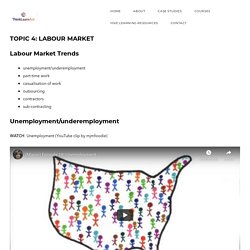
Almu january 2019.